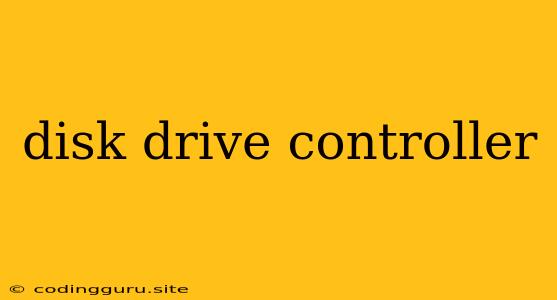Understanding the Crucial Role of a Disk Drive Controller
The heart of any computer system, whether it's a desktop, laptop, or server, relies on the ability to store and retrieve data efficiently. This is where the disk drive controller comes into play. You might be wondering, what exactly is a disk drive controller and why is it so important? Let's delve into the details.
What is a Disk Drive Controller?
Essentially, a disk drive controller acts as a translator and manager between the computer's central processing unit (CPU) and the storage devices, like hard drives, SSDs, or floppy drives. Imagine it as a traffic cop directing the flow of data between your computer's brain and its memory. Without this controller, your computer wouldn't know how to access or store information on your drives.
Key Functions of a Disk Drive Controller:
- Data Transfer: The disk drive controller is responsible for managing the transfer of data between the CPU and the storage device. It reads and writes data to the drives, ensuring accurate and efficient data flow.
- Error Detection and Correction: During data transfer, errors can occur. The disk drive controller includes mechanisms to detect and correct these errors, ensuring data integrity.
- Sector and Track Management: The disk drive controller organizes data on the drive by managing sectors (small units of storage) and tracks (concentric circles on the disk). This organization allows the computer to access data quickly and efficiently.
- Drive Interface: The disk drive controller acts as an interface between the drive and the computer's motherboard. It uses specific protocols (like SATA or IDE) to communicate with the drive and translate data into a format the computer understands.
- Drive Spin-up and Control: When you access your hard drive, the controller sends commands to spin up the drive platter. It also manages the read/write head position to access the correct data on the disk.
How Does a Disk Drive Controller Work?
- Data Request: When the CPU needs to access data stored on a drive, it sends a request to the disk drive controller.
- Drive Selection: The controller identifies the correct drive based on its interface and address.
- Data Retrieval: The controller locates the specific sector and track containing the requested data on the drive and initiates the read operation.
- Data Transfer: The data is then transferred to the CPU through the data bus.
- Data Storage: Similarly, when the CPU needs to store data, the controller writes the data to the designated location on the drive.
Why is a Disk Drive Controller Important?
A disk drive controller plays a crucial role in:
- Data Storage and Retrieval: It enables the computer to access and store data on storage devices, making it possible to run programs, save files, and use various applications.
- Performance: An efficient disk drive controller can significantly impact your computer's performance. It optimizes data transfer speeds, reduces latency, and ensures smooth operation.
- Data Integrity: The error detection and correction mechanisms built into the controller help ensure data accuracy and prevent data loss.
Choosing a Disk Drive Controller:
When choosing a disk drive controller, consider the following:
- Interface: Make sure the controller supports the interface of your drive (e.g., SATA, IDE).
- Speed: Higher speed controllers (e.g., SATA 3) offer faster data transfer rates, improving overall performance.
- Features: Some controllers offer additional features like RAID support (which allows you to combine multiple drives for redundancy and performance), hot-swapping (allowing you to replace drives while the computer is running), or advanced power management.
Common Issues with Disk Drive Controllers:
- Driver Issues: Outdated or corrupted drivers can cause problems with the controller, leading to errors or performance issues.
- Hardware Failure: Just like any other component, a disk drive controller can fail. This could result in the inability to access your drives.
- Data Corruption: If the controller malfunctions, it can lead to data corruption on your drives.
Troubleshooting Tips:
- Update Drivers: Ensure you are using the latest drivers for your disk drive controller.
- Check for Hardware Conflicts: If you have recently added new hardware, check if it is conflicting with the controller.
- Run Hardware Diagnostics: Use diagnostic tools to check the health of the controller and the connected drives.
- Replace the Controller: If you suspect a hardware failure, you may need to replace the disk drive controller.
Conclusion
The disk drive controller is an essential component in any computer system. It acts as a bridge between the CPU and storage devices, enabling data transfer, error correction, and efficient drive management. Understanding its functions, importance, and potential issues can help you troubleshoot problems, ensure data integrity, and optimize your computer's performance. By recognizing the crucial role of this controller, you gain a deeper appreciation for the complex symphony of components that power your digital world.
